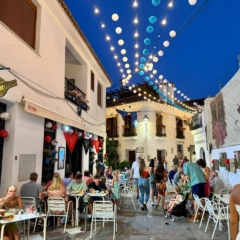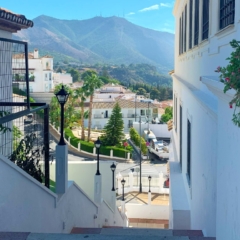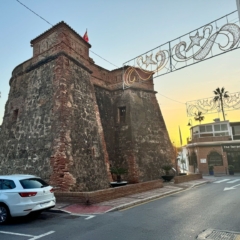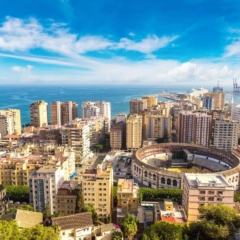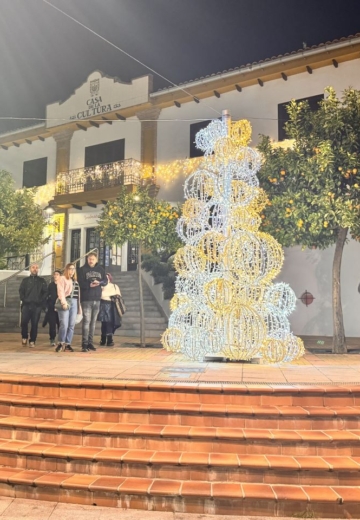Nerja Cave – tours, tickets, times, tips and traps!
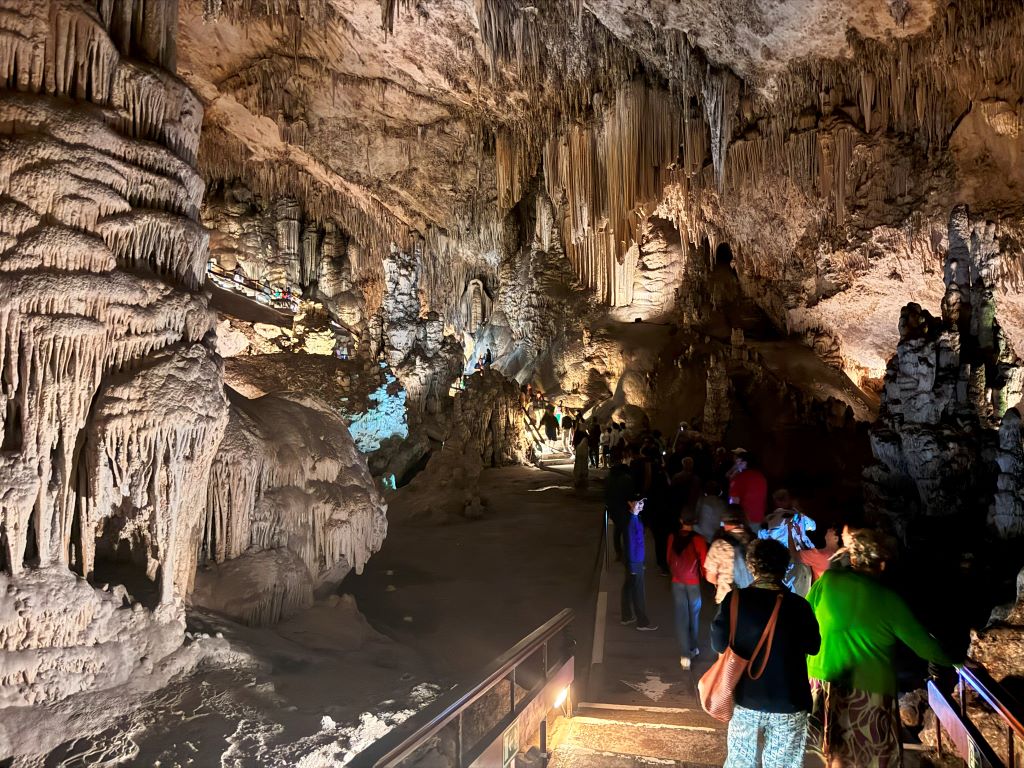
I recently visited the Nerja Cave (Cueva de Nerja) and – wow – it was fascinating! It is much bigger and more interesting than I expected, with great infrastructure and many surprises – both good and bad. It is so large that many people refer to it as the Caves of Nerja, even though it is only one cave! Come along as I share my tips and all the information so you can make the most of it and avoid a few traps. 😉
Get Your Guide fiasco
Whenever visiting a place for the first time, taking a tour is the best thing to do: you save time in planning, go directly to the best spots without getting lost and learn the most interesting bits about the place from professionals. Or so I think. Therefore, when my in-laws came from Estonia and wanted to visit the cave, we booked a Get Your Guide trip that would depart from Benalmadena to Frigiliana, Nerja cave and Nerja. Good, right? Unfortunately, it didn’t go as planned…
When we booked this trip, it didn’t say where the departing place was, other than Benalmadena. It didn’t give an address, but asked where I would like to be picked up. I gave my address.
After completing the process and payment, I received two confirmation e-mails from Get Your Guide, on different days, both stating my address as pick up place and the departing time at 9:00 am. My in-laws booked their own tickets and received the same e-mails.
The big day came and, as we prepared to leave, we received a phone call – it was the driver of the tour, in Spanish, saying we were not on the meeting place. It was 8;15 am, 45 minutes before the time I was given, and the location he mentioned, well, was some 20 minutes walking from my home!!! How come??
It turns out that Get Your Guide is for tours what Airbnb is for vacation rentals – they are intermediates, but don’t really know or control each tour operator (or house, in case of Airbnb). Some tours are great and well organized; others are not. We were not contacted by phone or message about another pick up place, nor informed that the address where we would like to be picked up would not be the address from were we would be picked up!! I learnt a lesson that day: only book tours that state the departing place clearly from the start of the booking process.
Well, this was frustrating. After a few attempts to contact the operator by phone (impossible) and a few minutes on the chat with Get Your Guide (with a promise of refund), we decided that we would not let a careless tour operator destroy our plans. We were going, even if we had to figure it all on our own!!!!

How to get to Nerja Cave
Nerja is a town in the province of Malaga, Spain, famous for its beautiful white houses with flowers on the balconies, great weather and two main attractions: the Balcón de Europa – a beautiful viewpoint overlooking the Mediterranean – and the cave of Nerja, located near Nerja and the small village of Maro. Nerja is a bit less than 60 km far from Malaga and a bit more than 80 km from Benalmádena, close to the border with the province of Granada.
Above: Nerja cave and its surroundings. The red dot marks the building that gives access to the cave.
There are several options to get to the Nerja Cave from Malaga and other cities in the Costa del Sol:
With a tour: despite my own bad experience, there is a tour to the Nerja cave, Nerja and Frigiliana, departing from Malaga, which states the departing point clearly. I think it can be worth giving them a try. This is not the fiasco tour operator that we booked:
The meeting point, Calle San Jacinto 1, is close to Malaga Centro Alameda train station, therefore easy to reach by train for those departing from Fuengirola, Benalmadena or Torremolinos as well.
By Bus: Alsa is the bus company that connects Málaga to the Nerja cave. You can check their site and even buy the tickets on-line for € 5,75 (as of this writing). Choose “Nerja (cuevas)” as destination, and the bus will let you right by the entrance of the cave complex. Just be careful to pick the departing point in Malaga clearly, as there are a few stops in the city; the one that simply says “Málaga” departs from the main bus station, shown below, right by Maria Zambrano train station. You can buy your coach tickets at the bus station too, if you prefer, and the trip lasts about 90 minutes.
By Uber, Bolt, taxi or car: the main highway to the Nerja cave is the A-7, which is perfectly paved and double lane all the way. It has a lot of curves, though. The view is beautiful and the speed limit is 120 km/h, less in some areas. Arriving at the cave’s complex, there’s a paid parking lot; it charges € 0,029 per minute up to 90 minutes, and € 0,021 per minute after that.
We checked with the taxis in Benalmadena and they estimated it would cost us around € 100 to get from Arroyo de la Miel to the cave of Nerja; Uber offered the ride from € 84, and Bolt, from € 66. A bit of search saves a lot! We arrived there in less than 50 minutes (our driver was a lightning Bolt)!

Cave of Nerja opening times
In general, the visitation hours of the cave are from 9:30 am to 4:30 pm, every day of the week, with last admission at 3:30 pm. During Christmas season and other long weekends in December and November, the visitation time is extended by one hour – up to 5:30 pm, with last admission one hour before closing time; during summer and the Holy Week, the visitation times go until 7 pm, also with last admission one hour before.
As the administration of the cave can change it at any moment, it is recommended to check the visitation times on the webpage of the Cueva de Nerja (on the bottom of their homepage).
Getting tickets to the Cave of Nerja
You can buy your ticket ahead, on-line, and it costs € 15,50. If you prefer to buy tickets in the complex, it will cost a bit more (€ 17,50) and you’ll face a queue. I usually buy things ahead, but as the tour we had booked included tickets, we had to do everything on the go – and the line took a while.
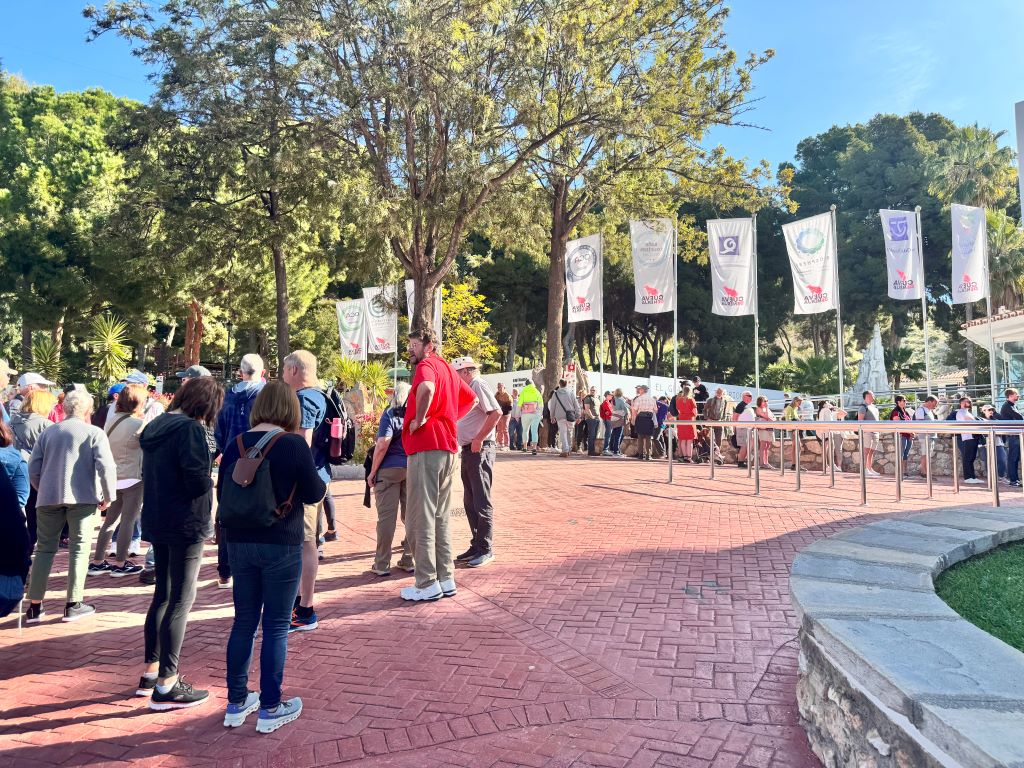
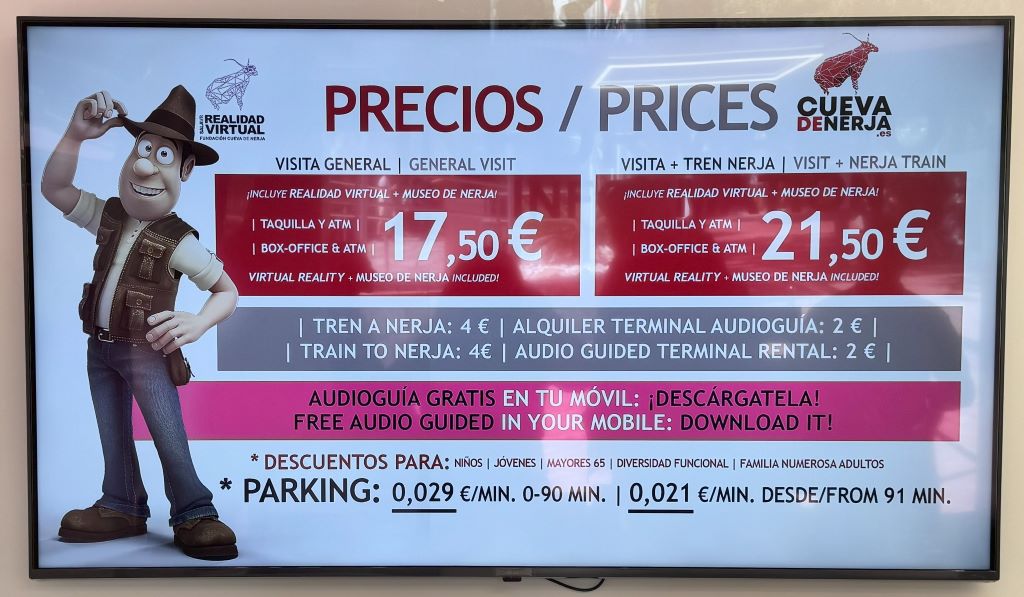
The ticket to the cave also includes entrance to the VR room and to the Museum of Nerja – you can’t buy only the ticket to the cave. You can also buy a ticket to go from the cave complex to Nerja city on a sightseeing train – more about all that on the next topics!
The area around Nerja cave
The area surrounding the cave itself is well developed and adorned by beautiful gardens. There is everything you would expect from a major touristic destination: a large parking lot, toilets, a restaurant with a magnificent view, a gift shop and even a playground and a picnic area.
There are also trails departing from the grounds along a botanical garden, and a VR room, where a virtual visit of the cave is available. The VR room is especially suitable for kids, as the movie is narrated by a cartoon, but also interesting for adults, as some of the areas of the cave are closed for visitors for preservation.

Talking about kids, the recommended age to visit the cave of Nerja is from 6 years old, but younger kids are also accepted. I would not recommend taking them, though, as there are more than 400 steps inside the cave (you won’t even notice, because you’ll be too amazed, but for little legs each step is a climb). A bit older kids, though, can enjoy not only the cave but also (mainly?) the VR Room. Spanish schools around the area take their pupils to visit the cave of Nerja – and the ones I saw were having a blast!
Below, a few pictures of the area. Click on the images to enlarge. 😉 From top left to bottom right: the exterior of the VR room; a view of the beginning of the botanical garden trail; the garden and signalization around the complex; the restaurant; the entrance to the cave itself and the gift shop.
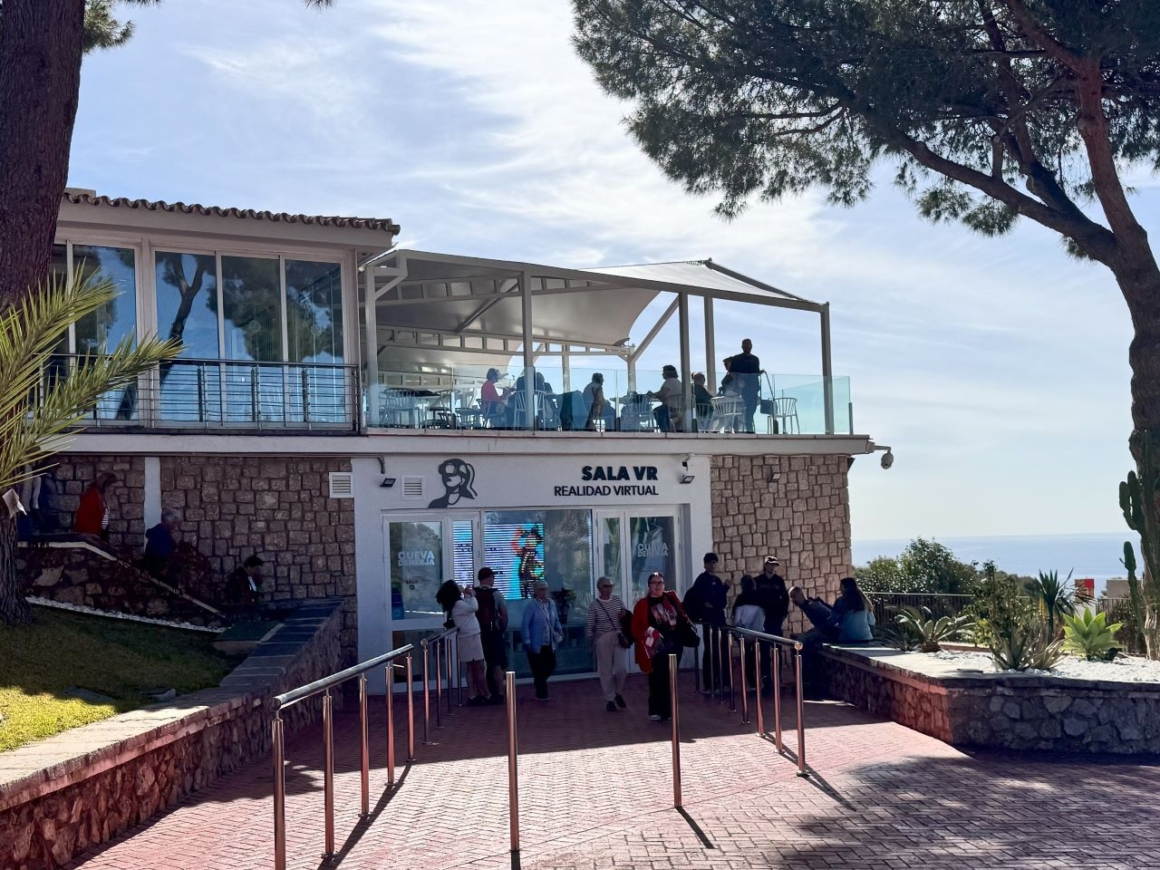


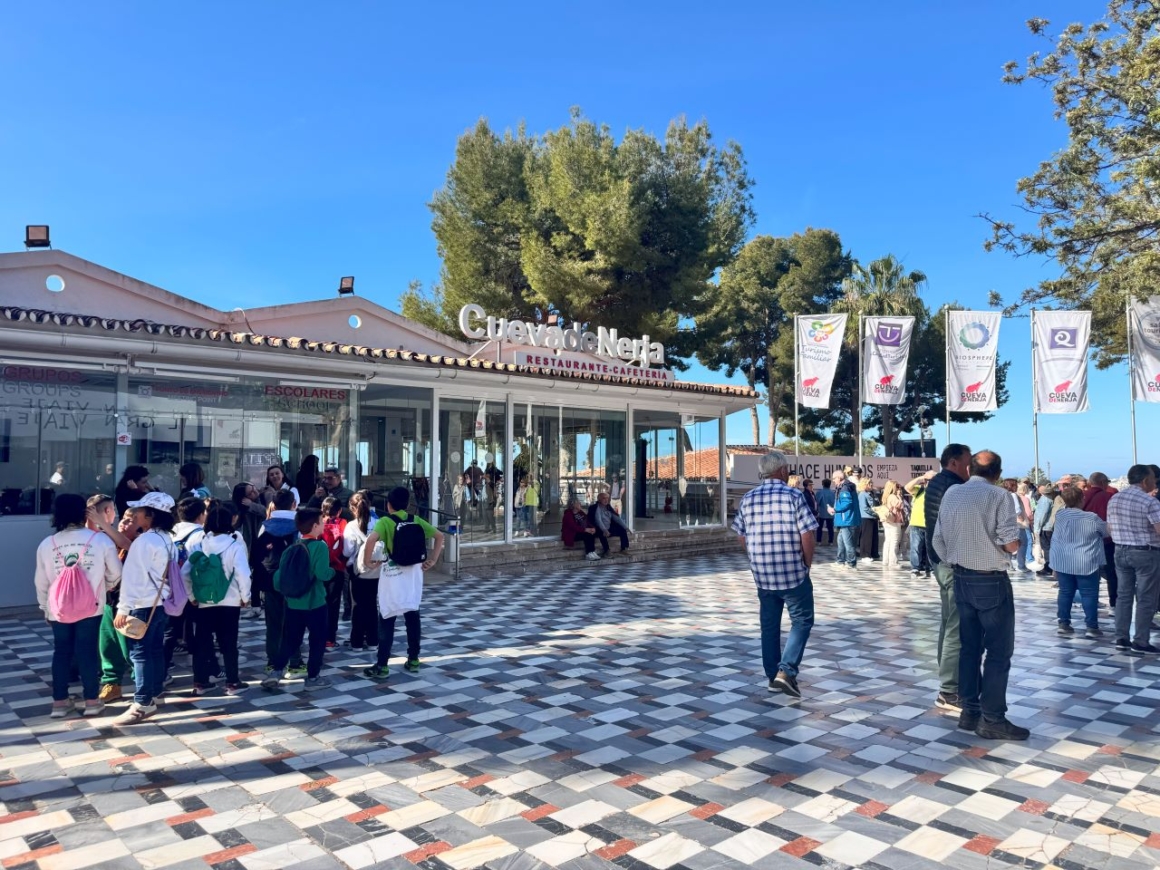


Did you notice something missing? The Museum!!! Access to the Museum of Nerja is free when purchasing the ticket to the cave, but the museum is not here at all – it is in the town!!! I’ve visited it a few hours later, and I’ll show it on the post about Nerja! 😉
The discovery of the cave
The Cave of Nerja was discovered in January 1959, and the exterior grounds praise the history of the discovery itself. It happened when a group of 5 school-aged boys noticed some bats coming out of a hole in the ground. Get away, right? Stay far! No, their mothers were not nearby. Instead, they decided to go into the hole to see where it would lead.
The boys not only went into the cave, but explored 4 out of the 5 chambers open to visitation presently. They only stopped and decided to run away when they encountered 2 human skeletons laying on the floor!!!
They told the story to their teachers, that accompanied them to a new visit to the cave; a few months later, it was a photographer who visited the cave with the boys and soon the Diario Sur, a newspaper of Malaga, told the world about the cave of Nerja. One and a half years after the first visit, in June 1960, the Nerja Cave opened for visitors – and has been attracting more and more people since then.
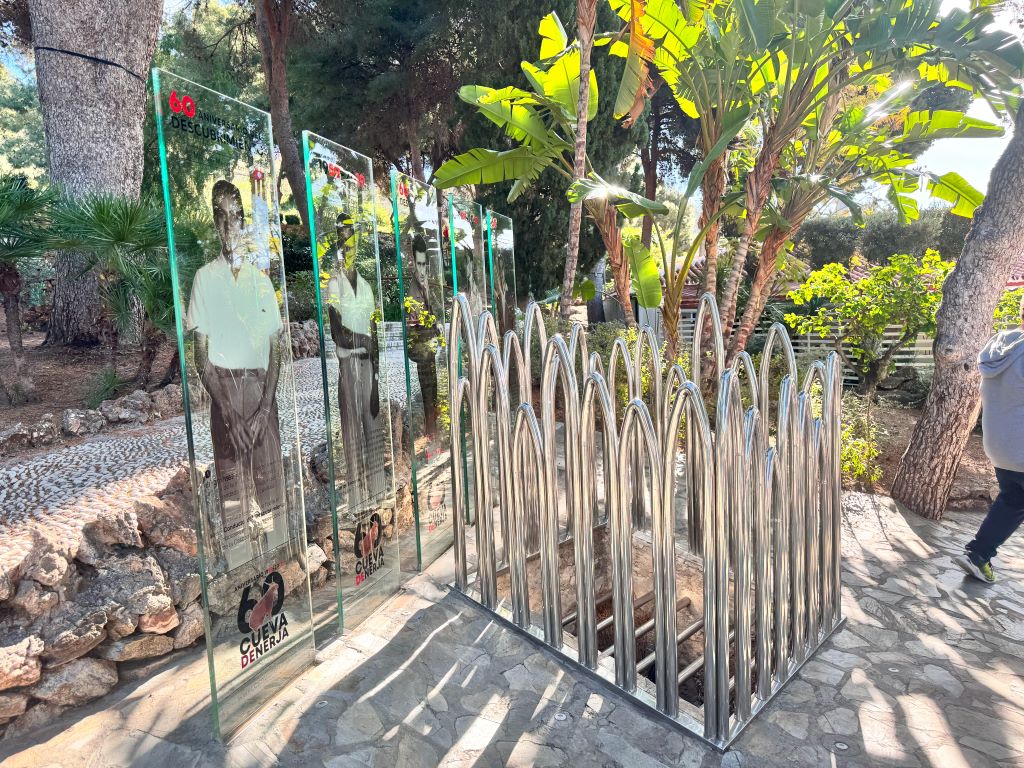
Into the Cave of Nerja
Nowadays, there are no bats in the cave (at least, I didn’t see any) nor skeletons (same). There is a great infrastructure, though, clear signalization, comfortable paving and lights, plus a lot of care to allow visitors safety and preserve the geological marvel and the history inscribed on the walls of the cave of Nerja.
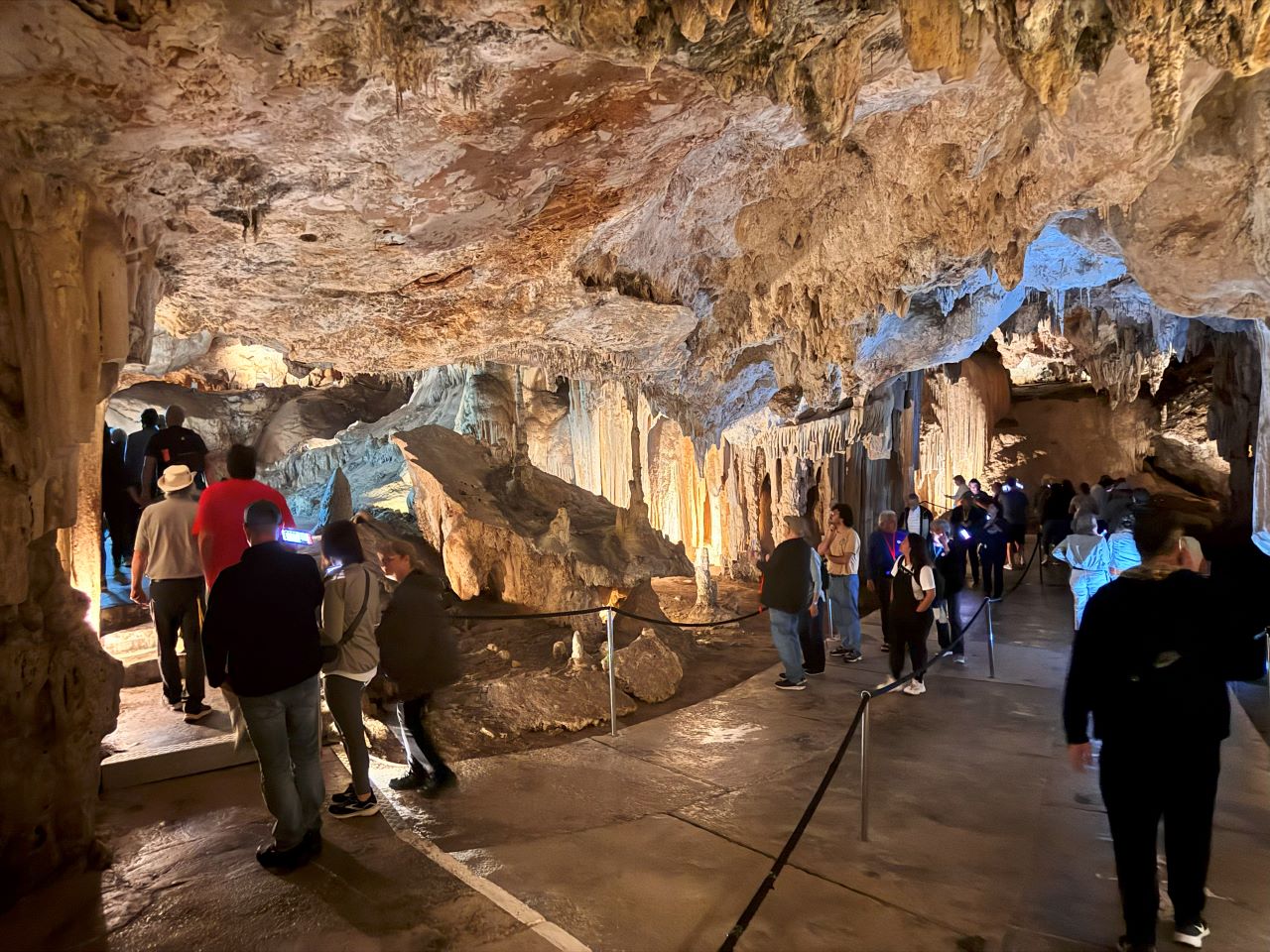
As you can see above, the floor is paved and there are guidelines indicating the way to follow while visiting the cave. There is no chance of getting lost. Taking pictures is allowed in the cave, as long as no flash is used. You may notice some people with phones on their ears; that is because it is possible to download an audioguide before entering the cave (because there is no internet connection inside). It is free, but it requires the cave’s app – links for Iphone and Android here. You can choose among several languages, English included.
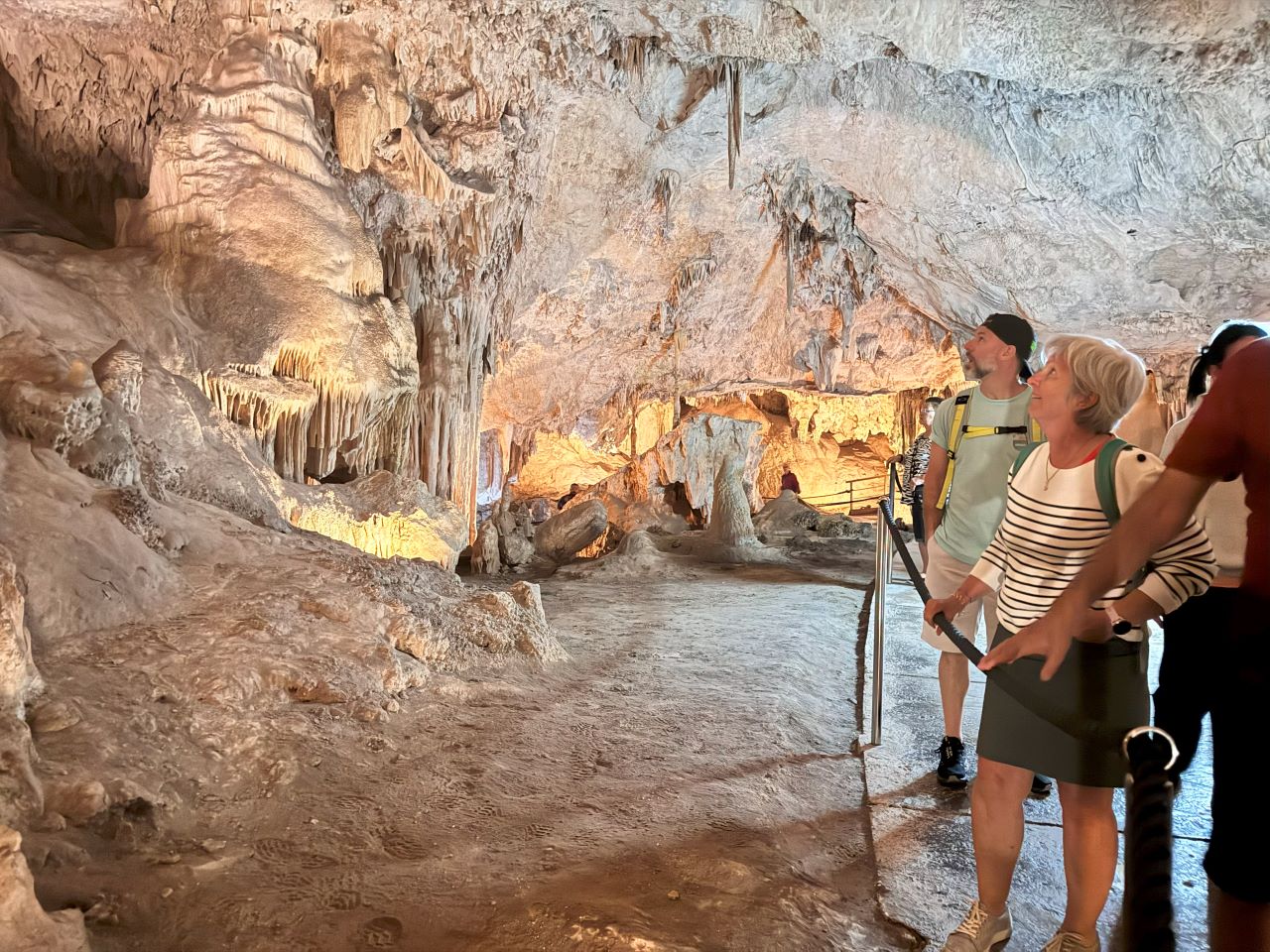
I did download the audioguide (while in the lightning Bolt), and started hearing it in the cave; the audios are a bit long, though, for someone that is on the move and wants to take pictures of everything. I think that other people were facing the same problem, as there were way more people with phones in their ears in the beginning that in the end of the tour. Be smarter than us: take earbuds with you, so you can hear and take pictures at the same time.

There is only one cave, and it is long, deep, tall and vast. It is enormous. The initial rooms (Sala del Vestíbulo / Lobby Hall and Sala del Belén / Nativity Hall), shown above, are the parts that were inhabited by humans during the paleolithic age; the cave entrances were larger back then. There are cave paintings from that time, but they are mostly out of the way of the visitable area – I didn’t see any – probably for preservation.
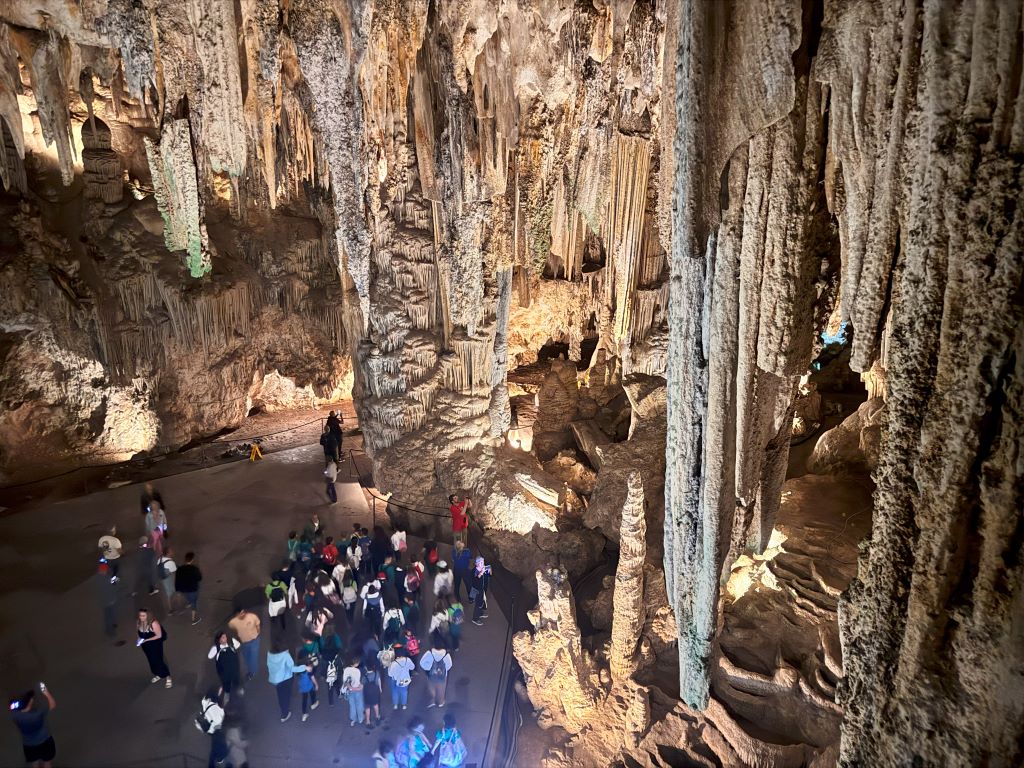

A glimpse of the size of the cave: this is the Hall of the Cascade, also called Ballet Hall (Sala de las Cascadas or Sala del Ballet). This last name comes from the time the cave was first open for visitation, in 1960, when ballet presentations happened in this chamber of the cave!!! As a matter of fact, this part of the cave was used as a theater and hosted the Festival of Music and Dance Cueva de Nerja every summer until 2019, 😵 when it moved outside, to an area by the current parking lot!
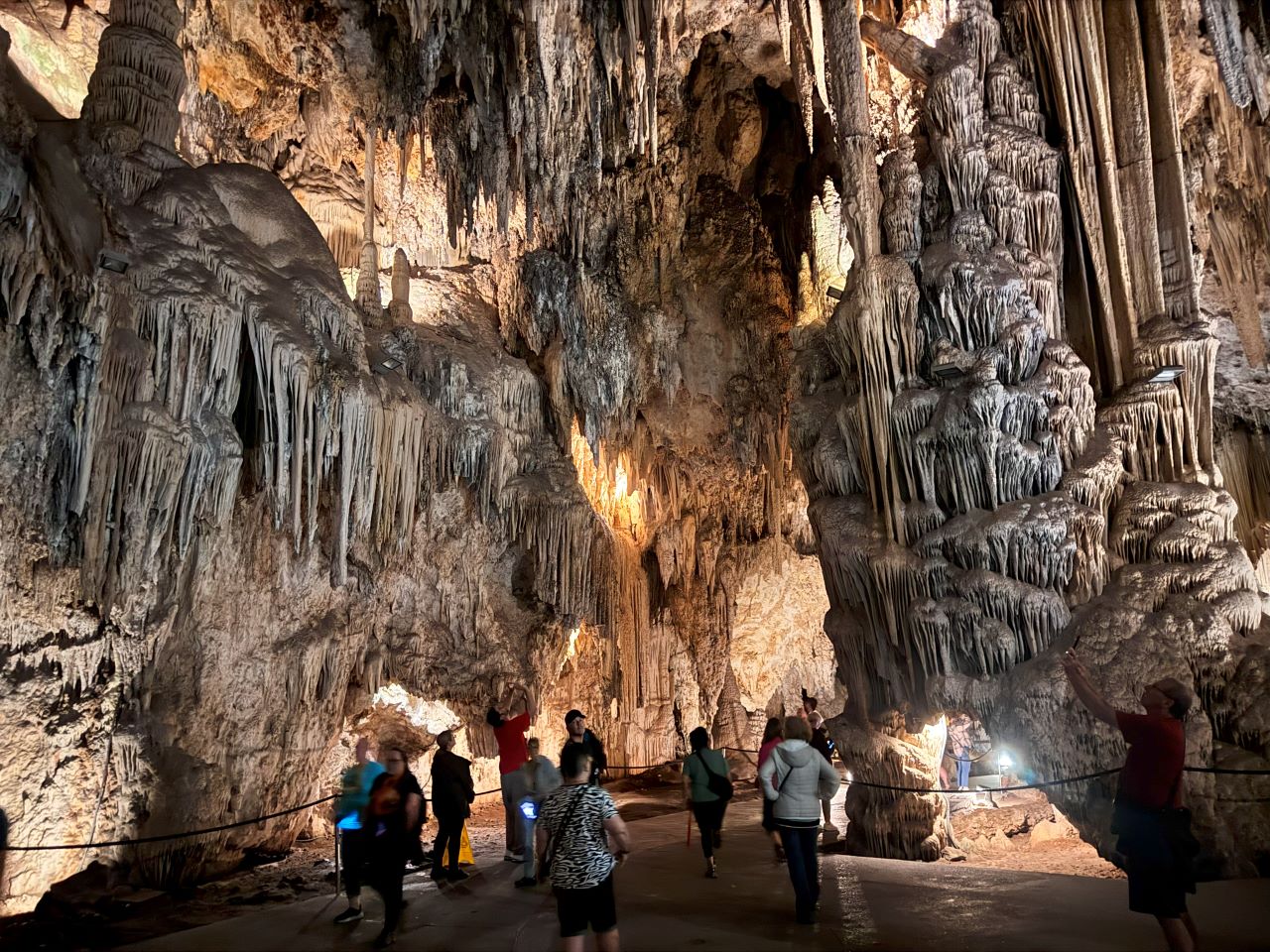
The temperature in the cave varies little; it remains between 17o C and 21o C all year long. It is a bit humid, though, and in places you can even notice a bit of water dropping. The cave itself is said to have started forming some 5 million years ago – and it is still forming!


I had seen pictures of the cave before visiting it, but it is just being there that one gets the real sense of how gigantic these spaces and formations are. I try my best to transmit the dimensions here with the pictures, but I’m afraid it is still much bigger than it looks. Check the people along the path and notice how small they appear in the images; this may help give an idea of the truly unbelievable size of this underground space.

I think this area of the cave is the part called the Ghosts Hall (Sala de los Fantasmas). The name comes from the eerie shadows cast by some of the rocks, according to the audioguide (that I heard after coming home, still very impressed); I suspect it may also be due to the skeletons that the initial explorers found in this part of the cave. Can you imagine that the five kids came this far into the cave, back when there were no stairs, lights or anything?!

Parts of the cave were used as burial sites. Many more skeletons of the paleolithic were found by further investigators, and to this day the cave remains an active research site. There are many nooks and entrances that are visible from the visitor’s path but are out of reach; some of these are still being studied or guard precious prehistoric artefacts, true treasures of nature and human history. Some of such findings were transferred from the cave and are now displayed in the Museum of Nerja.
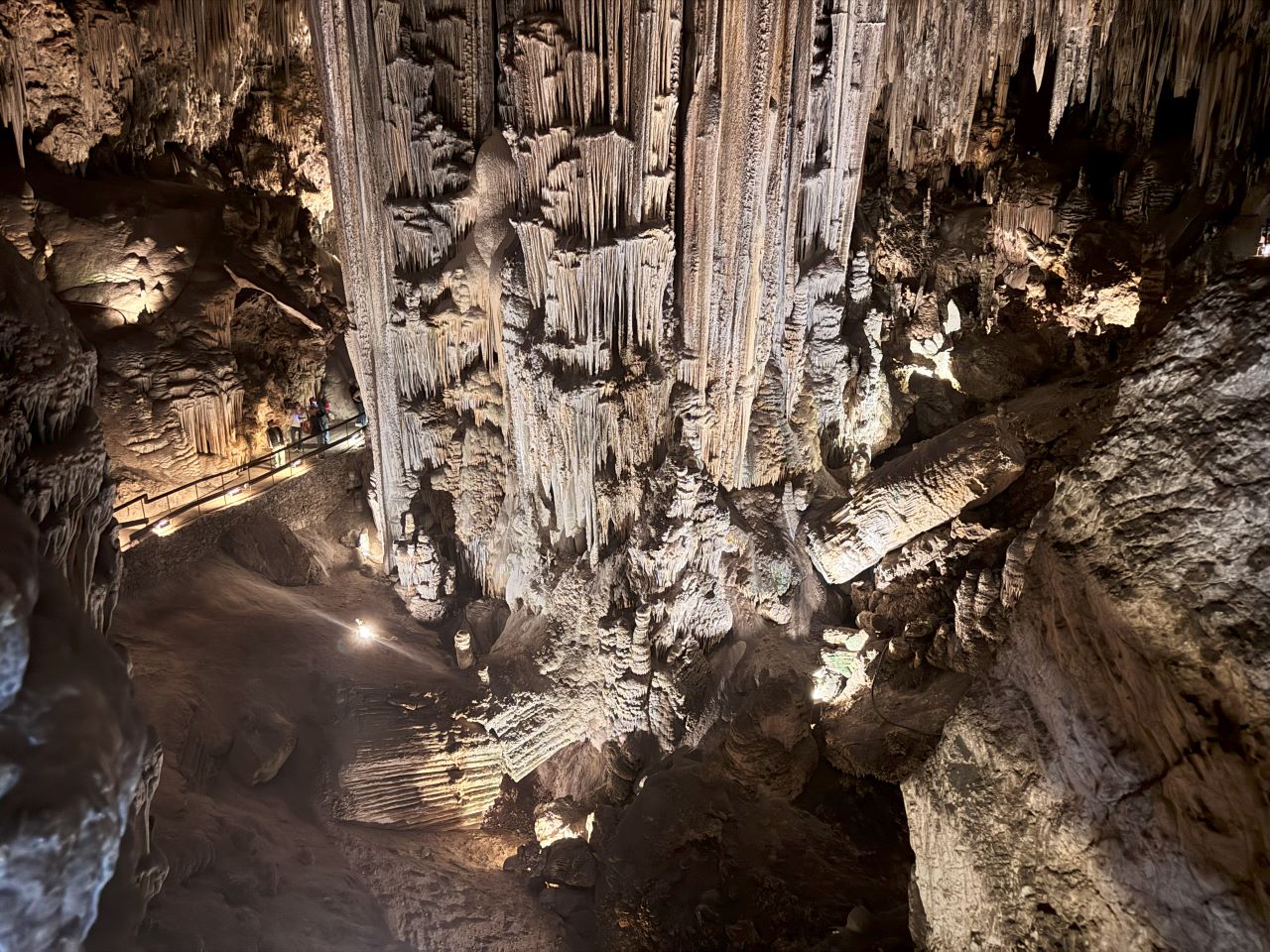
The final and most impressive chamber (in my opinion) is the Cataclysm Hall (Sala del Cataclismo), seen in the image above and in the ones below. It owes its dramatic name to an earthquake some 800.000 years ago that made some of the natural pillars of the cave crumble.
The central column that appears both above and below measures (staggering) 32 meters – about the height of a ten story building – and is in the guiness book as the tallest of its kind in the world.
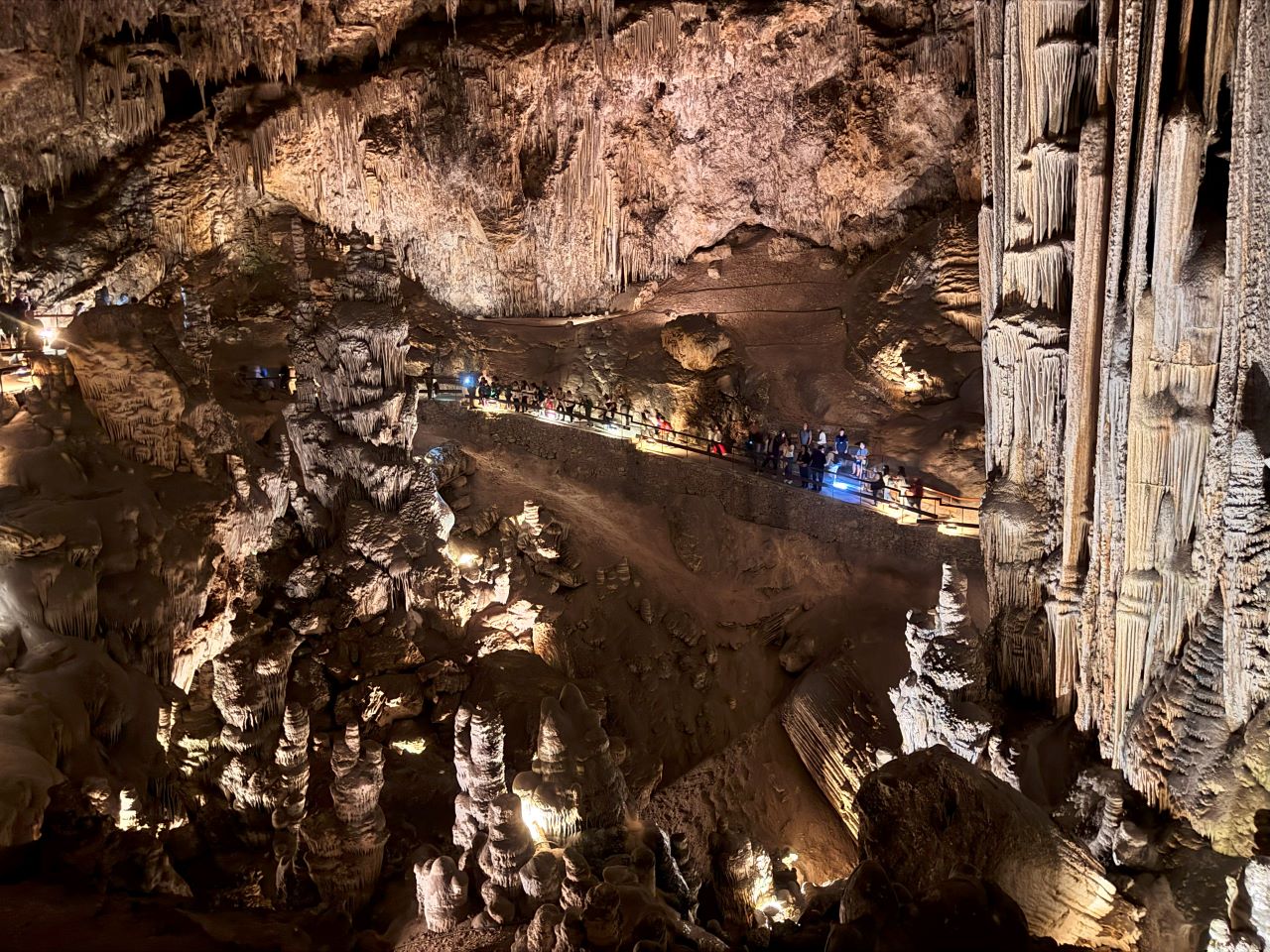
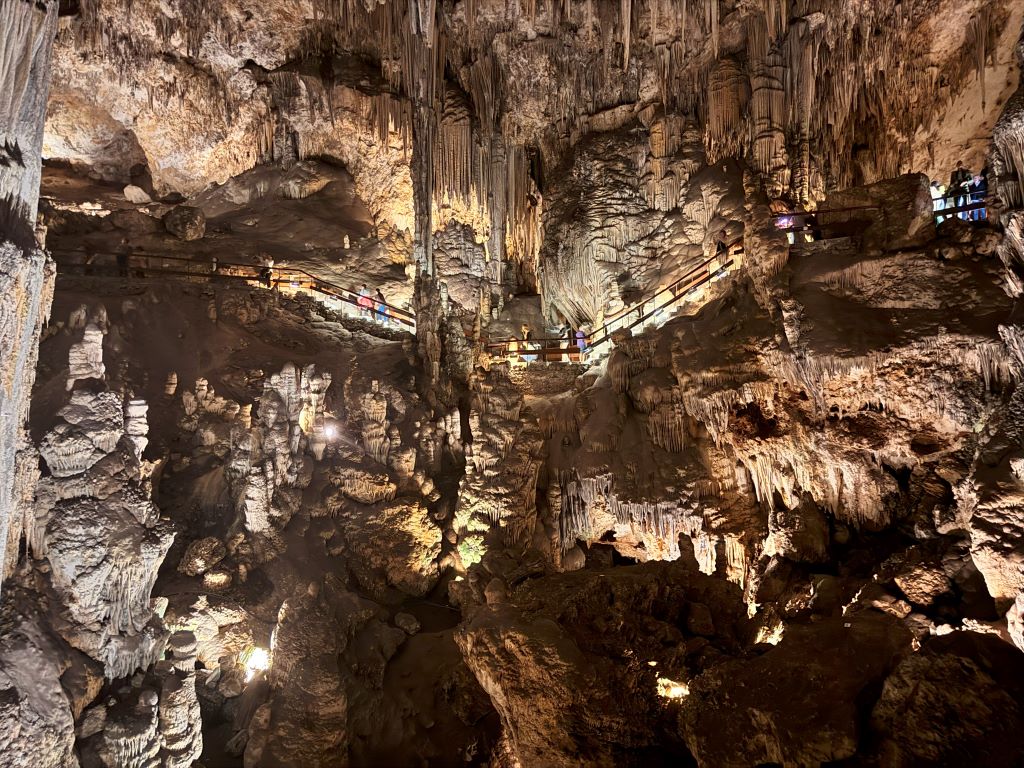
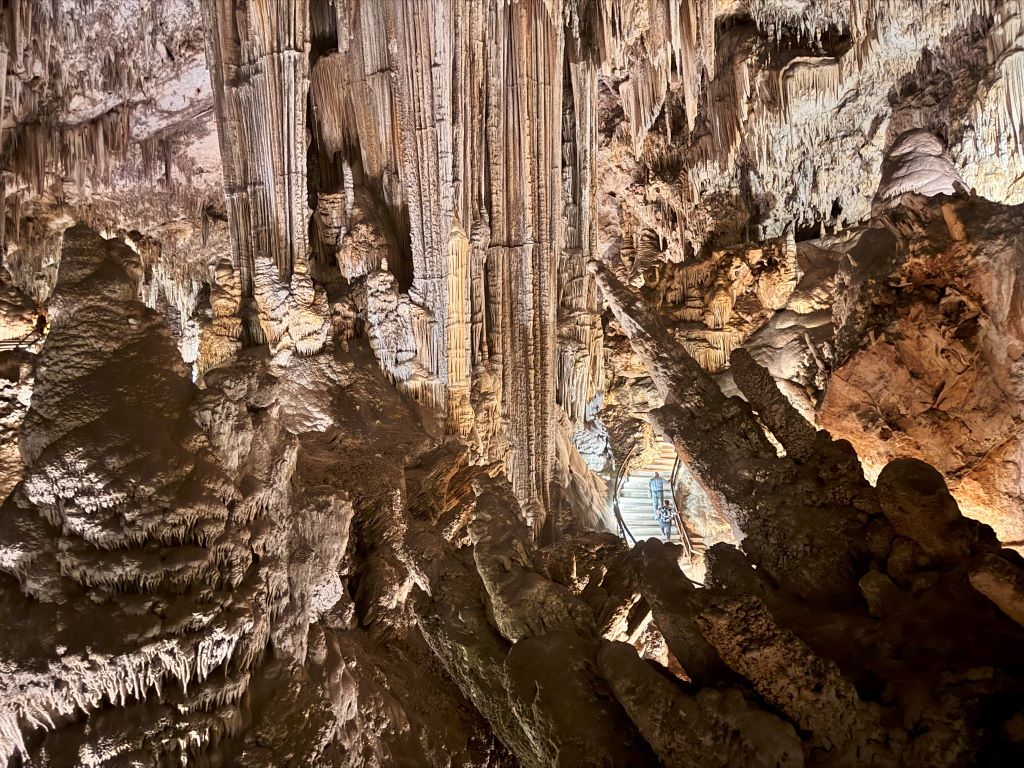
Kinda huge! And that is just a part of the intricate underground complex of this cave. The full map, shown below, divides the tourist areas from the other 2 thirds of the cave. The part called Galerias Turísticas (touristic galleries) includes the Halls of the Lobby, Nativity, Ballet, Ghosts and Cataclysm that were shown above and that can be visited; the other rooms of the touristic galleries and the other two parts of the cave are closed either for preservation or for safety reasons.
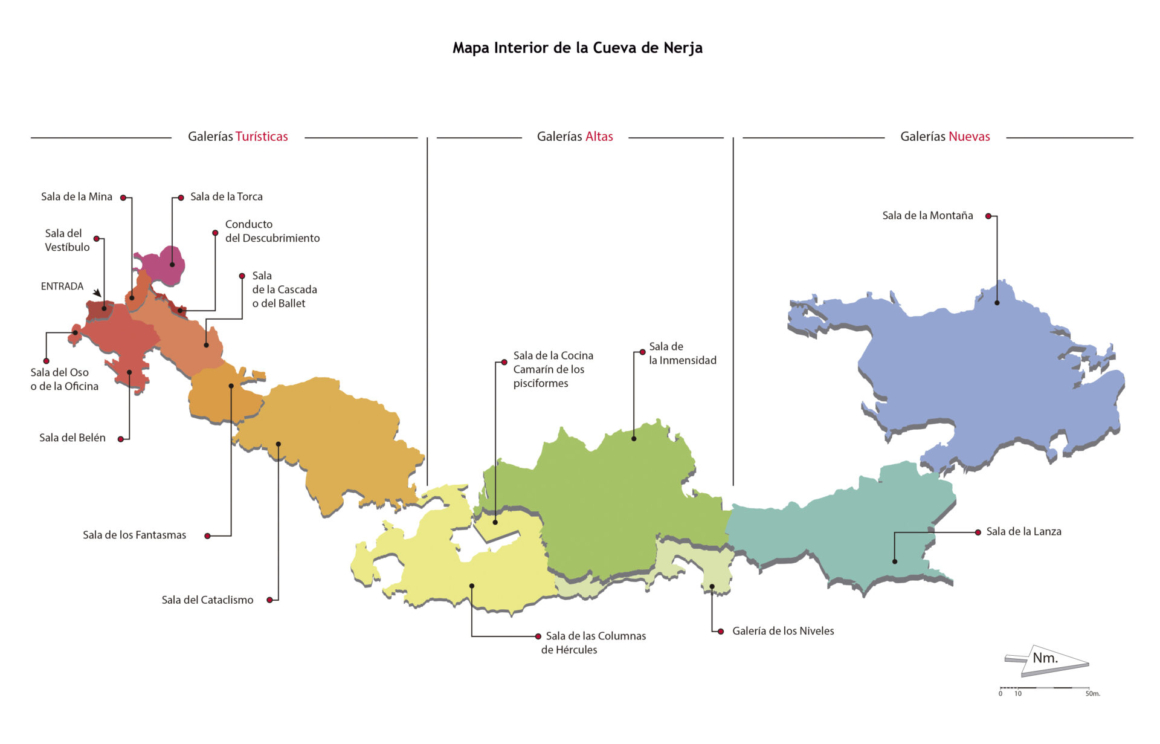
It took us about one hour to visit the interior of the cave. After that, back in the outer world, we were still mesmerized but ready to continue our adventure!
Going from the cave to the town of Nerja
After visiting the cave, the best thing to do is to head to Nerja and visit the lovely seaside town. You can do it either by bus – the bus stop is right by the entrance arch and costs less than € 2 – or by train. Not a train like Renfe’s, but this cute red sightseeing train, that charges € 4 per person.

We took the train. We had not bought train tickets with the cave tickets, but the driver accepted us paying to him directly (in cash). We were lucky to find the train preparing to depart completely by chance, while trying to find the bus stop. I loved it! Well worth the two-euros-something extra. We went slowly, enjoying the breeze and the views while taking lovely pictures on the way – I’ll show them in the next post, the one that is all about Nerja! See you there!
Conclusion
By the way, Get Your Guide did refund my in-laws for the fiasco with that tour; I’m still waiting for my own refund, but they did say it would take about a week. I would recommend getting a tour (a good one!) to visit the Cave and Nerja, to save you the struggles of finding the place, figuring out transportation and avoiding the queue for the ticket (though this last one can be minimized by buying on-line).
On the one hand, we managed to have a great time without a tour, with the advantage of visiting everything on our own pace; on the other hand, all the unknowns took us a lot of time, and therefore we ended up not going to see Frigiliana. Tour or not, Nerja cave is a great, jaw-dropping attraction and I think it was the high point of my in-laws’ visit to the Costa del Sol. I think you’ll like it too!
